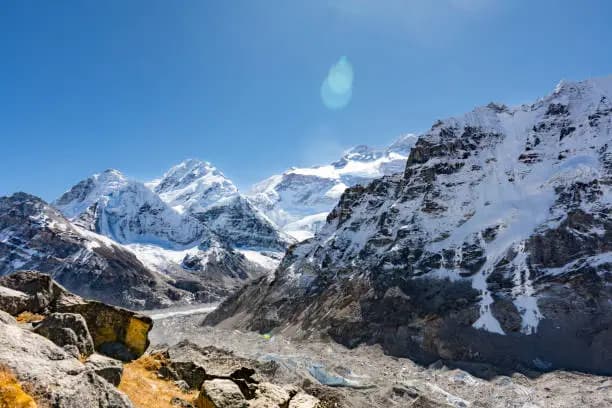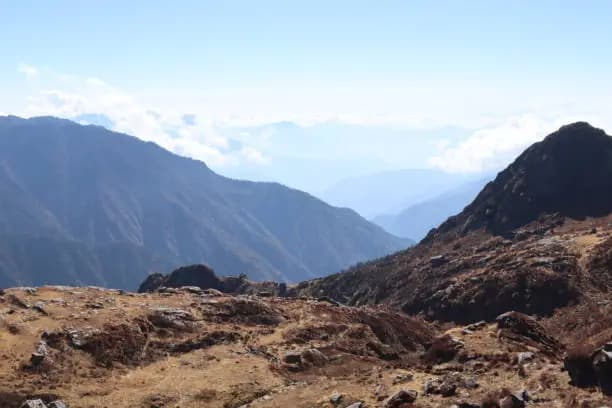The Goechala Trek in Sikkim is one of those journeys that make you question your limits and fall in love with the mountains at the same time. Before you decide, let us together set the backdrop and talk about the main issue – Goechala Trek Difficulty. It is quite a sight, but it is not a stroll for the weekend.
Why Everyone Talks About Goechala Trek Difficulty
This trek has something magical. You start from lush forests, walk through wooden bridges, cross meadows, and slowly climb towards the snow. Every few hours, the view changes. But so does the challenge. And that’s what defines the Goechala Trek Difficulty – it keeps testing you without warning.
How Difficult Is the Goechala Trek Difficulty Level, Really?
Let’s be honest – it’s not an easy one. It’s not impossible, either. Somewhere between moderate and hard. If you’ve done a trek or two before, you can manage. But you’ll sweat for it.
Here’re the reasons that add to the difficulty:
- Elevation: Your journey starts at an altitude of around 5,600 feet and goes up to 15,100 feet. That is quite a leap. Some people experience nausea, and mild headache comes along.
- Long days: A daily schedule of 6–8 hours of walking is just about right. Some stretches feel endless.
- Steep Trails: There are climbs that burn your legs and descents that test your knees.
- Cold Temperatures: Especially at Lamuney or Thansing, nights can freeze you.
- Basic Facilities: Camps are simple. No fancy stays, no cafes – just tents, food, and stars.
So the Goechala Trek Difficulty is mainly due to the combo of altitude, cold, and the fact that you have to walk long hours each day.
The Best Way to Prepare for Goechala Trek

Be patient with yourself, and if you have not already, start your preparations a few weeks ahead at least.
You don’t need to be a gym freak, but basic fitness helps a lot.
Try this routine:
- Walk or jog 4–5 km daily.
- Take the stairs rather than the elevator.
- Do lunges or squats for endurance-building.
- Breathe slowly – it is helpful in thin air.
On your walks, carry a backpack to get accustomed to the weight.
The Goechala Trek Difficulty is not hard at all if your legs and lungs are ready.
Weather and Altitude – The Real Game Changers
To be frank, you can’t predict the Himalayas. One minute it’s sunny, next it’s snowing or foggy. That’s part of the fun but also a big reason why people find the Goechala Trek Difficulty higher than expected.
Weather, rain, and lack of oxygen can start taking you down. The best way is to keep your cool, sip water, and walk your pace. The slower your pace, the more your body gets accustomed.
Best Time to Do Goechala Trek
The season decides half the challenge.
- April to May: Warm days, blooming rhododendrons, and friendly weather.
- October to November: Clear skies and the best mountain views, but colder nights.
- Avoid monsoon months. The trail becomes slippery and leeches love that season (no joke).
Mind Over Muscle
Jokes apart, even the fittest trekker can feel low sometimes. The real battle starts in your head. You’ll miss home, feel tired, maybe even think of giving up. That’s normal. Just keep walking, laugh with your group, enjoy the silence of nature. That’s what the mountains teach – patience.
Want to know more about other breathtaking Himalayan routes? Check out our detailed guide on treks in Sikkim for unforgettable adventures.
Quick Tips to Handle Goechala Trek Difficulty
- Drink plenty of water.
- Keep energy bars handy.
- Layer up your clothes; don’t wear heavy jackets all day.
- You should not measure your speed against others’.
- Take in the whole trail and not just the final spot.
When the first ray of sunlight strikes Mt. Kanchenjunga, you’ll be left with no memory of the hardships.
Watch this stunning travel YouTube vlog to see what the Goechala Trek truly looks like and feel the thrill before you even start your journey.
Also Read: Find how the Goechala Trek in Winter offers a completely different charm with snow-covered trails and serene mountain views.
Final Thoughts
The Goechala Trek Difficulty may look imposing but if you are physically fit and mentally strong, it is still within your reach. It is not about being first to the peak – it is about enjoying the experience. The mountains indeed challenge you but at the same time, they also give you rewards that you cannot tell.
FAQs
1. Is Goechala Trek tough for beginners?
Let’s be honest, it’s a bit tough. But with some basic training and a strong mind, beginners can finish it.
2. How many days does it take?
Usually around 8 to 10 days. Depends on weather and your fitness.
3. Can I do it alone?
To be frank, not a good idea. Go with a group or guide – the route gets confusing in places.
4. What’s the toughest part?
The last stretch from Lamuney to Goechala Viewpoint. Cold, thin air, and long distance make it hard.
5. Is the Goechala Trek worth all this effort?
Jokes apart, yes. Every single step. The view of Kanchenjunga at sunrise is unforgettable.















